coolant AUDI A3 2011 Owner´s Manual
[x] Cancel search | Manufacturer: AUDI, Model Year: 2011, Model line: A3, Model: AUDI A3 2011Pages: 320, PDF Size: 75.79 MB
Page 206 of 320
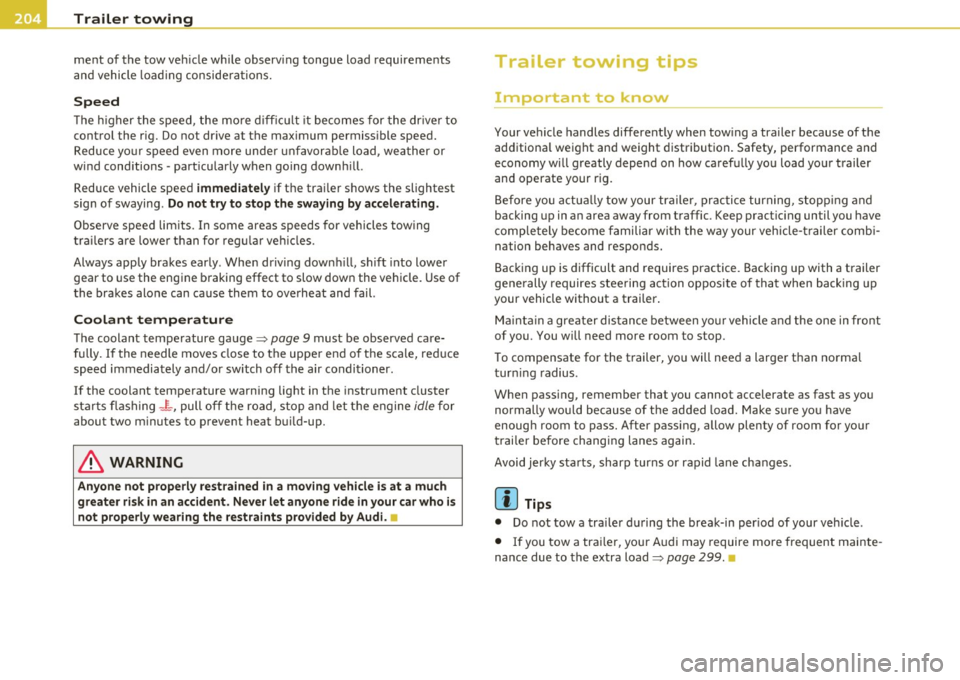
Trailer towingL _____________________________________________ _
ment of the tow vehicle while observing tongue load requirements
and vehicle loading considerations.
Speed
The higher the speed, the more difficult it becomes for the driver to
control the rig. Do not drive at the maximum permissible speed. Reduce your speed even more under unfavorable load, weather or
wind conditions -particularly when going downhill.
Reduce vehicle speed
immediately if the trailer shows the slightest
sign of swaying .
Do not try to stop the swaying by accelerating.
Observe speed limits . In some areas speeds for vehicles towing
trailers are lower than for regular vehicles .
Always apply brakes early . When driving downhill, shift into lower
gear to use the engine braking effect to slow down the vehicle. Use of
the brakes alone can cause them to overheat and fail.
Coolant temperature
The coolant temperature gauge~ page 9 must be observed care
fully. If the needle moves close to the upper end of the scale, reduce
speed immediately and/or switch off the air conditioner .
If the coolant temperature warning light in the instrument cluster
starts flashing
-t-, pull off the road , stop and let the engine idle for
about two minutes to prevent heat build-up.
& WARNING
Anyone not properly restrained in a moving vehicle is at a much
greater risk in an accident. Never let anyone ride in your car who is
not properly wearing the restraints provided by Audi. •
Trailer towing tips
Important to know
-------------
Your vehicle handles differently when towing a trailer because of the
additional weight and weight distribution. Safety, performance and
economy will greatly depend on how carefully you load your trailer
and operate your rig.
Before you actually tow your trailer, practice turning, stopping and
backing up in an area away from traffic. Keep practicing until you have
completely become familiar with the way your vehicle-trailer combi
nation behaves and responds.
Backing up is difficult and requires practice. Backing up with a trailer
generally requires steering action opposite of that when backing up
your vehicle without a trailer.
Maintain a greater distance between your vehicle and the one in front
of you. You will need more room to stop.
To compensate for the trailer, you will need a larger than normal
turning radius .
When passing, remember that you cannot accelerate as fast as you normally would because of the added load. Make sure you have
enough room to pass. After passing, allow plenty of room for your
trailer before changing lanes again.
Avoid jerky starts, sharp turns or rapid lane changes.
[I] Tips
• Do not tow a trailer during the break-in period of your vehicle .
• If you tow a trailer, your Audi may require more frequent mainte
nance due to the extra load~
page 299. •
Page 227 of 320

Checking and filling -------------- ------=------=:;______,.Jl':fffll
Checking and filling
Engine hood
Releasing the engine hood
The engine hood is released from inside the vehicle.
-Open the driver's door.
Fig. 159 Driver's side
footwell : engine hood
release lever
- Pull the release lever on the left under the instrument
panel ::::;, fig . 159 in direction of the arrow.
The hood pops up slightly und er spring pressure. •
Vehicle OP-eration
Opening the engine hood
Fig. 160 Engine hood
release lever
Before opening the engine hood, make sure that the wind
shield wipers are folded flat against the windshield. Other
wise , they could damage the paint on the hood.
Pull the release lever::::;, fig. 160 in the direction indicated
by the arrow. This release the hook under the hood.
- Open the hood all the way.
& WARNING
Hot engine coolant can burn you!
• To reduce the risk of being burned, never open the hood if you
see or hear steam or coolant escaping from the engine compart
ment . Wait until no steam or coolant can be seen or heard before
carefully opening the hood. •
Vehicle care Do-it-yourselt service iTechnical data
Page 228 of 320

___ C_ h_ e_c _k _i _ n _g ~ a_n _d_ f_il _l_in _ g _________________________________________ _
Closing the engine hood
- Pull the hood down until the pressure from the strut is
reduced.
- Let the hood
drop down and latch in place . Do not try to
push it shut;
it may fail to engage=> &.
& WARNING
A hood that is not completely latched could fly up and block your
view while driving.
• When you close the engine hood, check it to make sure the
safety catch has properly engaged. The hood should be flush with
the surrounding vehicle body parts.
• If you notice while driving that the hood is not secured prop
erly, stop at once and close it. •
Working in the engine compartment
Be especially careful whenever you work in the engine
compartment!
Whenever you must perform any work in the engine compartment,
for example checking and filling different fluids, there is a risk of
injury, burns and accidents. To prevent personal injury always
observe the following WARNINGS. The engine compartment of any
vehicle is a hazardous area!~
&
& WARNING
To help avoid injury, before you check anything under the hood :
• Turn off the engine.
• Remove the ignition key.
• Set the parking brake fully.
& WARNING (continued)
• Move selector lever of automatic transmission to "P" (Park);
put manual transmission in Neutral.
• Always let the engine cool down. Hot components will burn
skin on contact.
• To reduce the risk of being burned, never open the hood if you
see or hear steam or coolant escaping from the engine compart
ment. Wait until no steam or coolant can be seen or heard before
carefully opening the hood.
• Keep children away from the engine compartment.
• Never spill fluids on hot engine components. They can cause a
fire.
• Never touch the radiator fan. The auxiliary electric fan is
temperature controlled and can switch on suddenly.
• Never open the coolant reservoir cap when the engine is still
warm. The coolant system is pressurized and hot coolant could
spray out!
• Protect your face, hands and arm from steam or hot engine
coolant by placing a thick rag over the cap when you open the
coolant reservoir.
• If work on the fuel system or the electrical system is necessary:
-Always disconnect the battery .
- Never smoke or work near heaters or open flames. Fluids in
the engine compartment could start a fire.
- Keep an approved fire extinguisher immediately available.
• To avoid electrical shock and personal injury while the engine is
running or being started, never touch:
- Ignition cables
- Other components of the high voltage electronic ignition
system.
• If you must perform a check or repair with the engine running: .,_
Page 229 of 320

___________________________________________ C..:__ h:..:.e ..:.c :..:. k.:.... i..:....n :..::g~ a:..:.n..:.... d::.:....: f..:. i.:..:ll :.:.i.:...:n ~g !...._.....Jfflll
& W ARNING (co ntinued )
-First, fully appl y the parking brake , move sele ctor lev er of
automatic tran smission to "P" (Park ); put manual transmis
sion in Neutral.
- Always use extreme caution to prev ent clothing , jewelry, or
long hair from getting caught in the radiator fan , V-belt s or
other moving p art s, or from contacting hot part s. Tie back hair
before starting , and do not wea r clothing that will h ang or
droop into the engine.
• Minimize expo sure to emission and chemical hazards~& .
& WARNING
California Proposition 65 Warning:
• Engine exh aust, some of its constituents , and certain vehicle
c omponents contain or emit ch e mical s known to the State of Cali
fornia to cause can cer and birth defects and rep roductive harm . In
addition , certain fluids contained in vehicle s and certain product s
of component wear contain or emit chem icals known to the State
of California to cau se cancer and birth defect s or other reproduc
tive harm.
• Battery posts, terminal s and related acce ssories contain lead
and lead compounds, chemicals known to the State of California
to cause cancer and reproductive harms . Wash hand s after
handling .
0 Note
When adding fluids, always make sure that they are pou red into the
proper co ntainer or filler opening, otherwise serio us damage to
vehicle systems w ill occur.
Vehicle OP-eration
ffi For the sake of the environment
To detect lea ks i n time, inspect the veh icle floor pan from unde rneath
reg ularly. If yo u see spots from oil or other vehicle fluids, have your
veh icle inspected
b y an au thori zed Au di dea le r. •
Engine compartment
A pp lies to vehicles : w it h 2.0 l t urbo. 4 -cyl ind er en gi ne
2.0 Liter, 4-cylinder turbo gasoline engine
(200 hp)
The se are the most importan t it ems that you can c hec k.
Fig . 16 1 Engi ne c om part men t: 2 .0 I , 4 -c yli nder t urbo
© Coolant expansion tank (-L ) ... ................. .
@ Windshield washer container (W ) .... .... .. .. .. .. .
® Engine oil dipst ick (orange) . ... .. .... .... ... ... . .
Vehicle care Do-it-yourselt service 235
243 231 ~
iTechnical data
Page 230 of 320
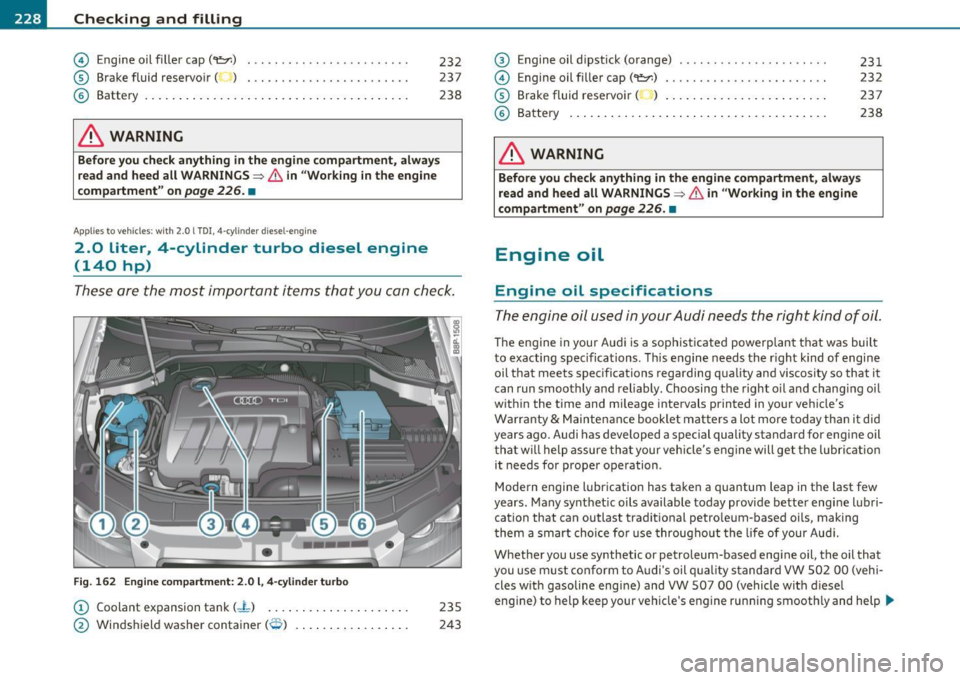
___ C_h_ e_c _k _i_n -=g :a,__ a_n_ d_ f_ i_ l _li _n _,g;._ __________________________________________ _
©
®
© Engine oil filler cap ('1:'=:?:)
Brake fluid reservoir ( )
Batte ry .... ...... .. .. .. .... ... ... ... .... ... .. .
& WARNING
232
237
238
Before you check anything in the engine compartment , alway s
read and h eed all WARNINGS =>
& in "Work ing in the engine
compartment" on
page 226. •
Applies to vehicle s: with 2.0 l TOI, 4 -cylinder diesel -eng ine
2.0 liter , 4-cylinder turbo diesel engine
(140 hp)
These are the most important items that you can che ck.
Fi g. 1 62 Engine comp artmen t: 2 .0 l, 4 -cyli nder tu rbo
(D Coolant expansion tank (J- ) ... . .. .... .. ... . .. .. .
@ Windshield washer container (~ ) .. .. ... .... .. ... .
235
243
®
©
®
© Engine oil dipstick (orange) ... .. ..... ... ... .... . .
Engine oil filler cap
('1:'=:?:) .................. .. .. . .
Brake fluid reservoi r ( ) ....... ...... ... .. .. .. . .
B atte ry .... . .. .... .. .... ... . .. .. . ... ... .. .. . .
& WARNING
231
232
237
238
Before you check anything in the engine compartment , alway s
r ead and heed all WARNINGS=>
& in "Work ing in the eng ine
compartment " on
page 226 . •
Engine oil
Engine oil specifications
The engine oil used in your Audi needs the right kind of oil.
The engine in your Audi is a sophisticated powe rp lant t hat was buil t
to exacting spec ifications . Th is engine needs the r ight kind of engine
oil that meets specifications regarding quality and viscosity so that it
can run smoo thly a nd reliably . Choosing the right o il and chang ing oi l
w ith in the time and mileage intervals printed in your vehicle 's
W arranty
& Mainte nance booklet ma tters a lot more today than i t did
years ago. Audi has developed a special quality standard for eng ine oil
t ha t wi ll help assure tha t your veh icle's engi ne will get t he lubri cat io n
it needs for proper operation .
Modern engine lu brication has take n a quantum leap in the last few
years . Many synt het ic oils available today provide be tte r engine lub ri
cation that can outlast tradit ional petro leum-based oi ls, making
t hem a smart choi ce fo r use througho ut the life of your Aud i.
Whether you use synthetic or petroleum-based engine oil, the oil that
you use mus t conform to A udi's oil quality standard VW 5 02 00 (veh i
cles wit h gasoline eng ine) and VW 507 00 (vehicle with diese l
eng ine) to help keep your ve hicle's engine runn ing smooth ly and help ..,
Page 236 of 320
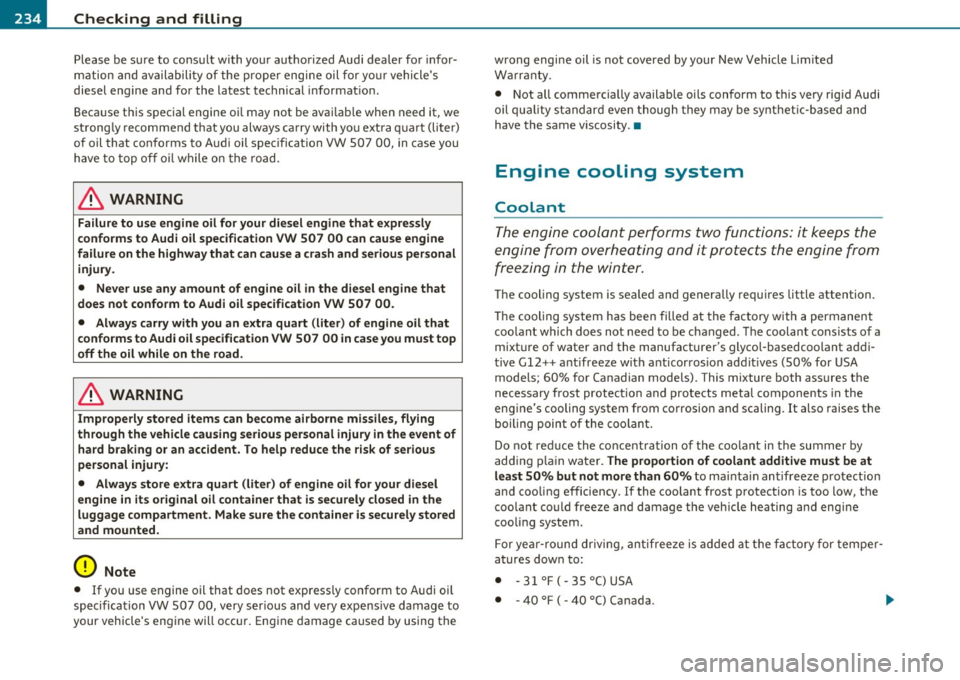
IJIII Checking and filling
-------=:---- =------------------------------------
Please be sure to consu lt with your aut horized Aud i dea ler for infor
m ation and availabili ty of the proper engine oil fo r yo ur vehicle's
diesel engine and fo r the latest technical informat ion .
Beca use t his spec ia l engine o il may not be avai lab le when need it, we
s tr ong ly recommend t hat yo u alw ays car ry with yo u extr a qu art (liter)
of oil that conforms to A ud i oil specificat ion VW 507 00, in case you
have to top off o il wh ile on the road.
& WARNING
Failure to use engine oil for your diesel engine that expressly
conforms to Audi oil specification VW 507 00 can cause engine
failure on the highway that can cau se a cra sh and serious per sonal
injury.
• Never use any amount of engine oil in the diesel engine that
does not conform to Audi oil specification VW 507 00 .
• Always carry with you an extra quart (liter ) of engine oil that
conforms to Audi oil specification VW 507 00
in case you must top
off the oil while on the road .
& WARNING
Improperly stored items can become airborne missiles, flying
through the vehicle causing serious personal injury in the event of
hard braking or an accident. To help reduce the risk of serious
personal injury:
• Always store extra quart (liter ) of engine oil for your diesel
engine in its original oil container that is securely closed in the
luggage compartment. Make sure the container is securely stored
and mounted.
0 Note
• If you use engine oil that does not express ly co nform to A udi o il
spe cifica tion VW 507 00, very ser ious and ve ry expens ive da mage to
your vehicle's eng ine will occ ur. Eng ine damage caused by using the wrong engine oil
is not covered by your New Vehicle Lim ited
W arran ty.
• Not all comme rcia lly available oils conform to t his very rigid Audi
oil qua lity stand ard eve n th ough they may be sy nth et ic -b as ed and
have the same v iscosity .•
Engine cooling system
Coolant
The engine coo lant per forms t wo functions: i t keeps the
engin e fro m ove rhea ting and i t pro tec ts th e engine from
f ree zin g in t he win ter .
The cooling system is sealed and genera lly requ ires little attention.
Th e cooling system has been filled at the factory wit h a permanent
coo lant which does not need to be c hanged. The coolant cons ists of a
mixt ure of water an d the manufacturer's glyco l-basedcoolant ad di
tive G12 ++ a ntifree ze with a nticorros ion addit ives (50% fo r USA
mode ls; 60% for Canadian models). This mixture both ass ures the
nece ssary frost protec tion and p rotects meta l components in the
eng ine's cooling system from corrosion and scaling. It also raises the
boiling poin t of the co olant.
Do not red uce the co ncent ration of the coolant in the summer by
add ing p la in water.
The proportion of coolant additive must be at
least 50 % but not more than 60%
to ma inta in an tifreeze protectio n
and coo ling efficiency. If the coolant frost protect ion is too low, t he
coo lant co uld free ze and damage t he veh icle h eating and eng ine
coo ling system.
F or ye ar-round drivi ng, an tifr ee ze is add ed at t he fa ctory for tempe r
atures dow n to:
• - 31°F( -35°C)USA
• -40 °F ( -40 °C) Canada .
Page 237 of 320

Checking and filling --------------------=------=:;______,.J VPII
You can mix the G12++ coolant additive with other additives G12+ or
Gl2. Always check with yo ur authorized Aud i dealer.
& WARNING
Before you check anything in the engine compartment, always
read and heed all WARNINGS =>
& in "W orking in the engine
co mpartment " on
page 226.
0 Note
• Before winter sets in, have the coolan t checked to see if the
coolant additive in your vehicle is sufficient to meet the clima te
conditions. This is especially important if you live in a region where
the winter is extremely cold . If necessary, increase the proportion of
coo lant additive to 60%.
• When adding coolant additive to your cooling system, remember :
- We recommend using only coolant additive
G12++ (check the
label) for your vehicle. This coolant additive is available at autho
rized Audi dealers. Other types of antifreeze can significantly
reduce corrosion protection . The resulting corrosion can cause a
loss of coolant and serious engine damage.
• Do not add any type of radiator leak sealant to your vehicle's
eng ine coolant. Adding radiator repair fluid may adversely affect the
function and performance of your cooling system and could result in
damage not covered by your New Vehicle Limited Warranty. •
Vehicle OP-eration
Checking the engine coolant level
The engine coolant level can be checked with a quick
glance.
Fig. 166 Engine
co mpartm ent: cool ant
expansion tank
Before you check anything in the engine compartment,
always read and heed all WARNINGS => & in "Working in
the engine compartment" on
page 226.
- Turn off the ignition.
- Read the engine coolant level from the coolant expansion
tank=> fig. 166 . With a cold engine, the coolant level
should be between the "min" and "max" markings. When
the engine is warm, the level may be slightly above the
"max" marking .
The location of the coolant expans ion tank can be seen in the engine
compartment illustration=>
page 227.
To obtain an accurate reading, the engine must be sw itched off.
The expans ion tank in your vehicle is equipped with an electric coolant
level sensor.
When the coolant level is too low, the warn ing light in the Auto-Check
System =>
page 32 will blink until you add coolant and the level has
been restored to normal. Even though there is an elect ric coolant
~
Vehicle care Do-it-yourselt service iTechnical data
Page 238 of 320
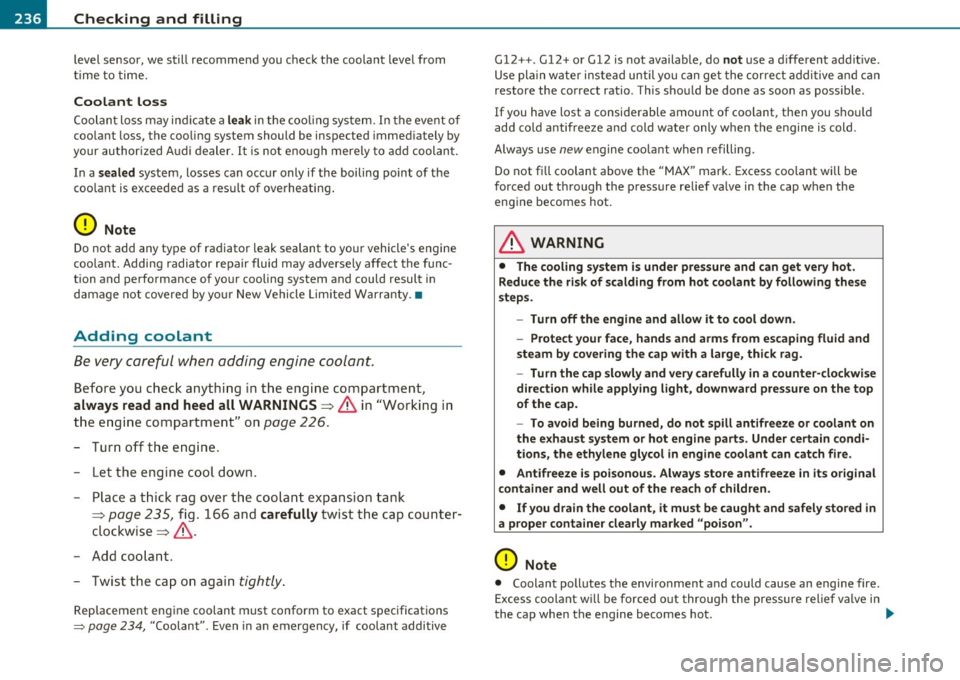
___ C_ h_ e_c _k _i _ n _g ~ a_n _d_ f_il _l_in _ g _________________________________________ _
level sensor, we still recommend you check the coolant leve l from
ti me to time.
Coolant loss
Coolan t loss may ind ic a te a leak in the coo ling sys tem. In the event of
coo lant loss, the cooli ng system should be inspected immed iately by
your au thor ized A udi dealer.
It is no t enough merely to add coolan t.
In a
s ealed system, losses can occur only if the boiling point of the
coo lant is exceeded as a res ult of overheating .
(D Note
Do not add any type of radiator leak sealant to yo ur vehicle's engine
c oo lant. Addi ng radia tor repa ir fluid m ay adverse ly affect the fun c
tion and perfo rmance of your cooling system and could result in
damage not cove red by yo ur New Vehi cle Lim ited Warranty .•
Adding coolant
B e very careful when adding engine coolant.
Before you check anyt hing in the eng ine compartment ,
always read and heed all WARNINGS=> & in " Working i n
the e ngine compartment" on page
226.
-Tur n off the eng ine.
- Let t he engi ne c ool d ow n.
- Place a thick rag over the coolant expansion tank
=> pa ge 235, fig . 166 and carefully twist t he cap cou nte r
clockwis e
=> &.
- Add coo lant.
- Tw ist the ca p on aga in
tightly .
Replacement eng ine coolant must conform to exact spec ificat ions
=> page 234, " Coolant" . Even in a n emergency, if coolant additive
Gl2 ++. Gl2+ or Gl2 is not available , do not use a d ifferent addit ive .
Use pla in w ate r ins tead until you can ge t the cor rect addi tive and can
restore the co rrect ratio . This sho uld be done as soon as possib le .
If you have lost a considerable amount of coolant, then you s houl d
ad d c old antifree ze and cold water only when the engine is cold .
Always use
new engine coo la nt w hen refilling .
Do not fill coolant above the "M AX" mark. Excess coo lant will be
forced out th rough the p ress ure relief va lve in the cap w hen the
eng ine becomes hot.
& WARNING
• The cooling system is under pressure and can get very hot.
Reduce the risk of scalding from hot coolant by following these
steps.
-Turn off the engine and allow it to cool down.
- Protect your face , hands and arms from escaping fluid and
steam by covering the cap with a large, thick rag.
- Turn the cap slowly and very carefully in a counter-clockwise
direction while applying light , downward pressure on the top
of the cap.
- To avoid being burned, do not spill antifreeze or coolant on
the exhaust system or hot engine parts . Under certain condi
tions, the ethylen e gly col in engine coolant can catch fire .
• Antifreeze i s poi sonou s. Always store antifreeze in it s original
container and well out of the reach of children.
• If you drain the coolant , it mu st be caught and safely stored in
a p roper container clearly marked "poison ".
(D Note
• Coolant pollutes the environment and could cause an engine fire.
E xcess coolant w ill be forced o ut thro ugh the pressure relie f va lve in
the cap when the e ngine becomes hot .
~
Page 239 of 320
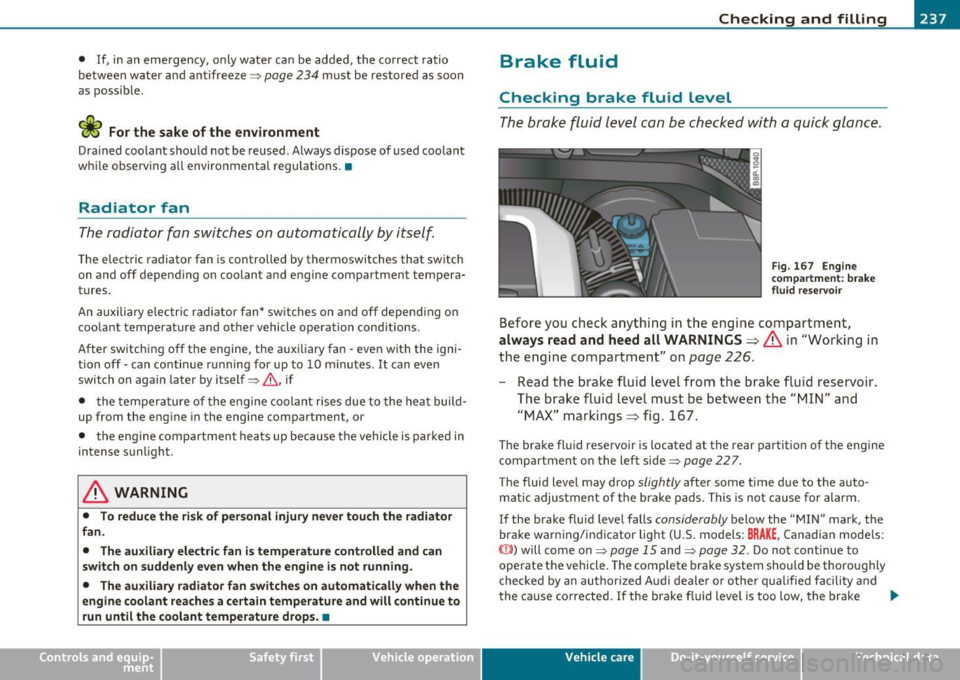
___________________________________________ C_ h _ e_c _k _ i_n -=g .._ a_n _ d_ f_i _ll _i _ n -=g '-- ....... m
• If, in an emergency, only water can be added, the correct ratio
between water and antifreeze=>
page 234 must be restored as soon
as possible.
~ For the sak e of the environment
Ora i ned coolant should not be reused . Always dispose of used coolant
while observing all environmental regulations .•
Radiator fan
The radiator fan switches on automatically by itself.
T he electric radiator fan is controlled by thermoswitches that switch
on and off depending on coolant a nd engine compartment tempera
tures.
An auxilia ry e lectr ic rad iator fan* sw itches on a nd off depend ing on
coo lant temperature and other vehicle operation cond itions .
After switch ing off t he engine, the auxiliary fan -even with the igni
tion off -can continue running for up to 10 minutes . It can even
switch on again later by itself=>& , if
• the temperature of the engine coolant rises due to the hea t build
up from the engine in the engine compartment, or
• the engine compar tment hea ts up because the vehi cle is parked in
intense sunlight.
& WARNING
• To reduce the risk of personal injur y never tou ch the radi ator
fan .
• The auxiliary ele ctric fan i s temperatur e controll ed and can
switch on sudd enly even wh en the engine is not running .
• The auxiliary radiator f an swit che s on aut omati cally when the
engine coolant reaches a certain temp eratur e and w ill continue to
run until the coolant temperature drop s. •
Vehicle OP-eration
Brake fluid
Checking brake fluid level
The brake fluid level can be checke d with a quick glance.
Fig. 167 Eng ine
compartment : b rak e
fl uid res ervoi r
Before you check a nything in t he engine compartment ,
always read and heed all WARNINGS~ & in "Working in
the eng ine compartment" on
page 226 .
-Read the brake fluid level from the bra ke fluid reservoir.
The brake fluid level must be between the "MIN" and
"MAX" markings ~ fig . 167 .
The brake fluid reservoir is located at the rear partition of the engine
compartment on the left side=>
page 227.
The fluid level may drop
slightly after some time due to the auto
m atic adjus tment of the brake pads. This is not cause for alarm .
If the brake fluid level falls
considerably below the "MIN" mark, t he
brake warning/ind icator light (U .S. models :
BRAKE, Canadian mode ls:
ill ) will come on=> page 15 and=> page 32. Do not continue to
operate the vehicle . The complete brake system should be thorough ly
chec ked by an au thor ized Aud i deale r o r other qualified facility and
the cause corrected. If the brake fluid leve l is too low, the brake .,,_
Vehicle care Do-it-yourselt service iTechnical data
Page 246 of 320
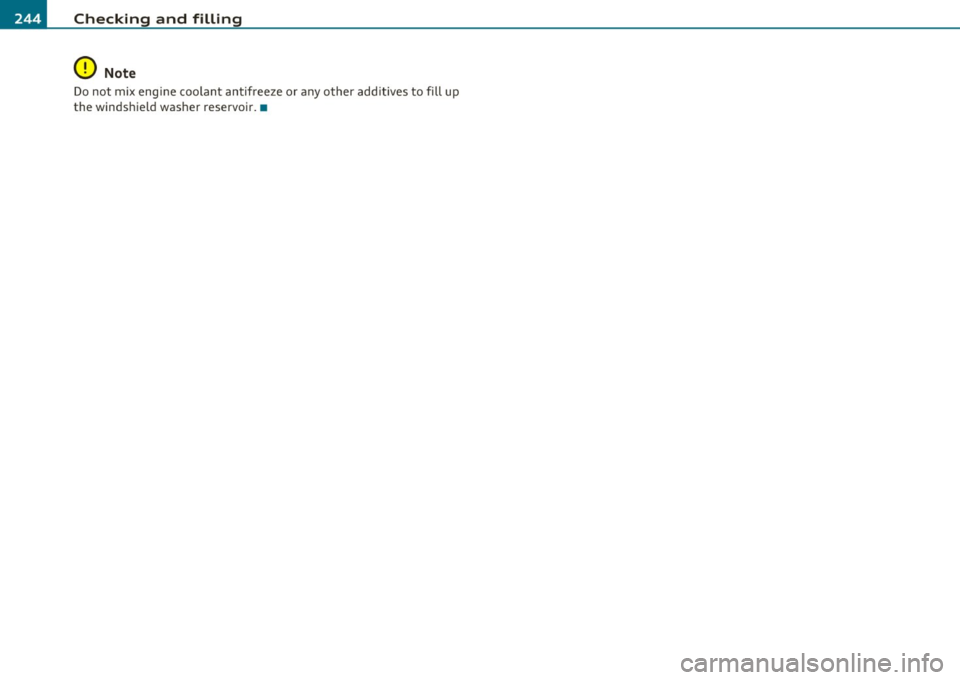
___ C_ h_ e_c _k _i _ n _g ~ a_n _d_ f_il _l_in _ g _________________________________________ _
0 Note
Do not mix engine coolant antifreeze or any other add itives to fill up
the windshie ld washer reservoir. •